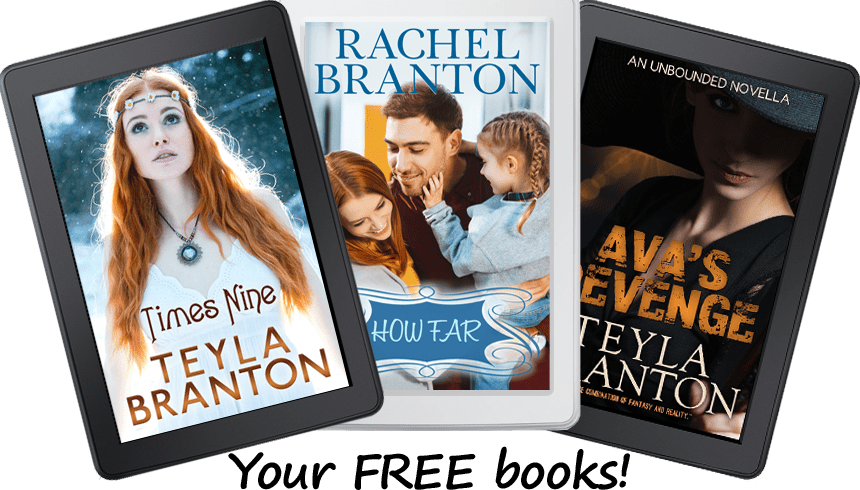
Novice writers who don’t know their characters tend to bog down their novels with long-winded backstory. They’ll be writing along, telling a great story, and then suddenly they’ll deviate into paragraph after paragraph of history that describes why their character responds a certain way.
Get to know your characters
Unfortunately, this kind of info dump is one way to kill your readers’ attention faster than just about anything else beside terrible grammar. One way to avoid this is to write about a character and the world she lives in before you begin the book. Give her a background, a history, and motivation for why she will respond the way she does. Spend time getting to know your character. (You can see more about characters and questions for a character sketch on my post Making Imaginary Characters Real.)
Leave it out
Then leave 90% of it out of the actual book. Post it on your blog, send it to your mother in an email, but leave it out of the book.
Will you use any of it? Yes, but only in small segments. Not as your reader needs the information, but earlier in the novel as kind of a foreshadowing. If you plug it in right when it’s needed, readers will say, “Hey, you just made that up to fit the plot. I don’t believe it.” If you do it correctly, however, the plot will flow naturally.
So you might ask why you wasted time writing and thinking about what will NOT go in the book? Isn’t that a waste of time?
Knowing your characters and world saves time
No. Definitely not. If you know your characters before you start writing, you’ll actually end up rewriting them less. Even though you may not include all the backstory in your novel, the feeling of it will come through in your dialogue and your characters’ action. You’ll know the basic rules of the world you created and stick to them. That’s not to say your character/plot/world won’t evolve. All of these will, but you’ll be able to keep it all straight, and it will happen more naturally instead of in huge chunks that makes readers’ eyes glaze over.
What about sequels?
Sequels have their own backstory issues. To sell sequels, you need to catch readers who missed the first book up on what happened—but they don’t need to know everything. If you do it right, they’ll go back and buy that first book. So don’t rehash the whole plot. Again, use backstory only when you need it to forward the plot. It’s okay to leave readers a bit curious for a while, even over several books in a series. In Patricia Briggs’ Mercy Thompson series, I believe it was three books before she finally fills us in on Mercedes’ family. In many cases, limiting backstory actually increases tension.
If a scene feels heavy, get out the scissors
If a scene feels bogged down, and you can’t figure out how to make it better, try rewriting with only dialogue and tiny bits of description, as if you’re writing a screenplay. This will help you decide how much backstory really is necessary and how much you’ve put in for yourself.
Here’s an example from my novel THE CURE (Unbounded #2), where my character is possibly entering into a dangerous situation and also thinking aboug Ritter, who she has purposefully left behind because she’s angry at him—and because she might have a thing for the informant she’s going to see:
I’m sure Ritter could figure out something to do with himself tonight. By the time I returned from the restaurant with any information I could squeeze from Keene, I bet he’d have Oliver, Mari, and even Stella in the sprawling dining room turned gym. We all ate in the large, drafty kitchen these days because training was more important. It meant survival. We hadn’t been in Oregon long enough to find better accommodations or rebuild this old hotel, and now it looked as though we wouldn’t be staying. I wasn’t sure where we’d go next, but I’d ask for somewhere warm if I had the chance.
“Okay, you stay out of sight,” I told Jace, as I drove slowly past the restaurant. “Just because you’ve never officially met Keene doesn’t mean he won’t recognize you. He’s probably seen your picture dozens of times.”
I’m sure your eyes were glazing. Mine did and I wrote the garbage. Definitely far too much backstory bogging the scene down, so I yanked it out during the rewrite. Now it reads:
I was sure Ritter could figure out something to do with himself tonight. By the time I returned from the restaurant with any information I could squeeze from Keene, I bet he’d have Oliver, Mari, Chris, and even Stella in the sprawling dining room turned gym, working on combat techniques.
“Okay, you stay out of sight,” I told Jace, as I drove slowly past the restaurant. “Just because you’ve never officially met Keene doesn’t mean he won’t recognize you. He’s probably seen your picture dozens of times.”
Much better this time, and it doesn’t slow down the dialogue or the plot.
Backstory VS flashbacks
Incidentally, some authors confuse backstory with flashbacks, but these are not the same thing, not really. Flashbacks are part of the history, to be sure, and they often let the reader know important things about the world, but backstory segments are not flashbacks. Properly written backstory segments are generally much smaller and worked into the narration and dialogue in a more natural way so as to be almost invisible. Flashbacks often will be more prominent and detailed.
Does your story begin in the right place?
Another tip is to ask yourself is if your novel is beginning in the right place. If you are wasting too much time telling about exciting events that occurred a few days earlier, maybe you should start your novel there.
Conclusion and a caution
To sum it all up, include backstory only in small segments and only when it furthers the plot. Anything else and you risk losing your audience. But DO include the necessary or your readers will be confused.
![]()



Writing Links Round Up 5/10 – B. Shaun Smith
[…] Backstory: How Not to Tell Too Much […]
Evyn Cook
I really found your article helpful, thx;) I was wondering about the prologue of a story. Is this an appropriate place to insert a memory or a piece of the characters background?
Teyla Rachel Branton
Yes, that absolutely can be done. The general rule is to NOT have prologues, but in fantasy and sci-fi, they are rather common. I’ve even used one or two myself. Just make sure that it’s catchy and ties back in later in the story!
Evyn Cook
Thx so much !
How Much Backstory is Too Much? – Renea Guenther
[…] Backstory: How Not to Tell Too Much How to Weave Backstory Into Your Novel Seamlessly How to Tell If Back Story Is Sabotaging Your Novel How to Write Backstory: When & How Much to Reveal How to write backstory but not bog down your book […]
Writing Links Round Up 11/5-11/9 – B. Shaun Smith
[…] Backstory: How Not to Tell Too Much […]
Leah
This was very informative. The novel I am writing at this time has a lot of backstory I have already written and I was swaying back and forth on whether I should include it or not. Now I see that I should simple save their backstory for later use and continue on, the reader unaware of the story I know. Thank you so much, Teyla!
Teyla Rachel Branton
You are welcome. Glad you enjoyed it. Thanks for your comment, and I wish you good luck!
Andrea Fingerson
Thanks for the example from your second book. A workshop participant recently asked me how much backstory to include in a second book. I gave her a similiar answer but I am on my final edits (I hope) before I send my book to agents, so I didn’t have an example to show her.
Teyla Branton
You are welcome. Good luck!
Harold
This was very helpful. Someone mentioned this to me today and I really didn’t understand what “too much telling” meant until I read this. It will help me fix my manuscript. Thanks!
Teyla Branton
Glad to help! Good luck!
Arun Debnath
Wonderful wisdom words. Sure it will help my writing now. Thanks for sharing with us.